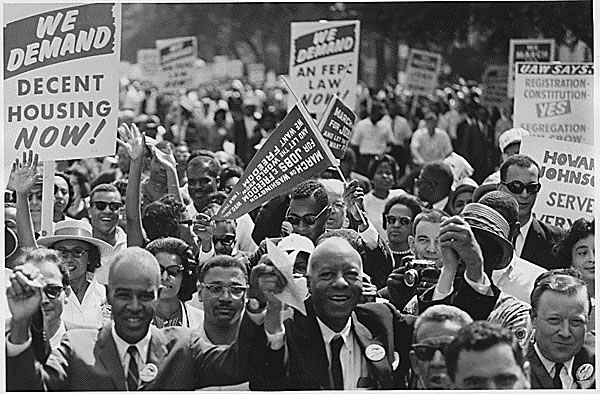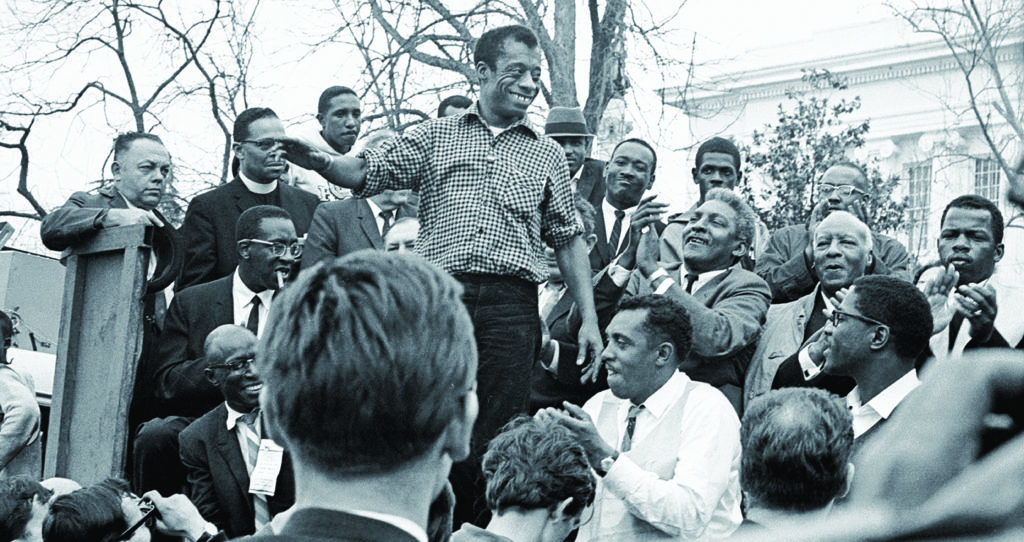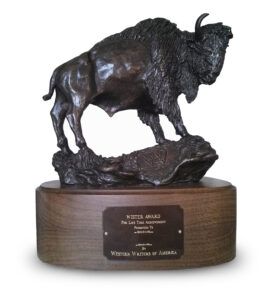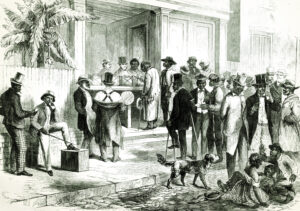In the war over civil rights, the two sides faced very different tasks. The enforcers of segregation were committed to maintaining the status quo everywhere. This put them at a disadvantage because they had so much territory to defend. The civil rights movement, by contrast, usually could pick the time and place of engagements. Once a campaign got under way, it also generally could set the tempo of action. Authorities could respond with harassing actions, ranging from traffic tickets to injunctions to even banning the state’s chapter of the NAACP, and they often resorted to violence. But even so, the initiative remained almost always with the forces of desegregation.
One of the best examples of the variety of novel operations available to the Movement was the Freedom Rides. In them, a small band conducted the equivalent of a daring but almost suicidal foray behind enemy lines. The best military analogy may be the Doolittle Raid, the American bombing attack on Japan early in World War II. In April 1942, just five months after the Japanese attack on Pearl Harbor, sixteen American B-25 bombers, each with a crew of five, took off from an aircraft carrier in the North Pacific—a job that their pilots had never done before and for which the planes had not been built. They flew toward Japan without their usual escort of fighter planes, making them enormously vulnerable if detected. What’s more, they left behind some of their defensive machine guns, in order to make the planes lighter and so extend their range. The fliers knew their mission was dangerous. Indeed, some of them would be captured by the Japanese and kept on starvation diets. Three of those taken prisoner were executed as war criminals.
GET HISTORY’S GREATEST TALES—RIGHT IN YOUR INBOX
Subscribe to our Historynet Now! newsletter for the best of the past, delivered every Wednesday.
The point of the American raid was not to inflict significant damage, but simply to boost the morale of the American public and damage that of the Japanese public by showing that the American military could retaliate for Pearl Harbor. The planes did in fact bomb the Japanese capital and five other cities. A less predictable consequence was the effect on the embarrassed Japanese military. As the military historian Adrian Lewis puts it, “The Doolittle Raid caused the Japanese to act rashly, which led to their defeat at Midway”—which became a major turning point in the war.
Likewise, the Freedom Riders—a small group of committed activists organized in May 1961 by James Farmer, national director of the Congress of Racial Equality (CORE)—rode buses from Washington, D.C., into the Deep South. They traveled light and penetrated deep into enemy territory, unprotected, to take their segregationist enemies by surprise both in their tactics and in their strategy. The sit-ins had taken place mainly in urban areas in the Upper South—Tennessee, North Carolina, and Virginia. The purpose of the Freedom Rides was, like a military raid, to carry the flag of the cause into previously untouched areas, even into rural areas of the Deep South. “We somehow had to cut across state lines and establish the position that we were entitled to act any place in the country, no matter where we hung our hat and called home, because it was our country,” Farmer explained.
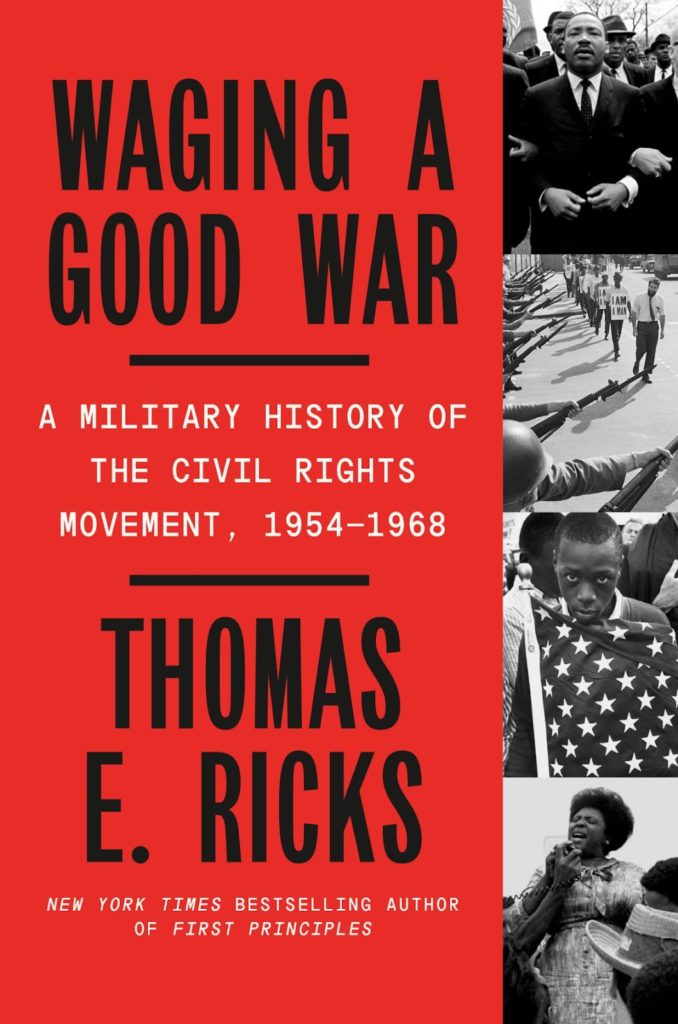
Waging a Good War: A Military History of the Civil Rights Movement, 1954–1968
by Thomas E. Ricks, Farrar, Straus and Giroux, October 4, 2022
If you buy something through our site, we might earn a commission.
A secondary goal was to get the attention of the Kennedy administration and try to push it off the fence on the issue of civil rights. The organizers had some reason to believe that the administration was ready to move. Just as the first Freedom Ride was getting under way, Robert Kennedy was preparing a speech on civil rights. It would be his first formal address as the attorney general in his brother’s fledgling administration. When he delivered it at the University of Georgia on May 6, 1961, he appeared to endorse the civil rights movement. “If one man’s rights are denied, the rights of all are endangered,” he stated. It was high time, he said, for the South to make some “difficult local adjustments.”
But even as Kennedy spoke, he was being overtaken by events. Before the month was out, the Freedom Rides would push him to put action behind his words challenging the South to begin making difficult changes. Unfortunately, he would fail that test.
From D.C. to the Deep South
A persistent advantage of the civil rights movement was that it was innovative and so was able to keep its opponents off-balance. Tactically, the Freedom Rides were “something new,” recalled Floyd Mann, then the director of the Alabama State Police, “something that the state police had not been confronted with in the past. We’d had local demonstrations by local people, but this was the first time we’d had an interstate movement on the part of people. It was just totally something new to law enforcement in Alabama. . . . It caught them . . . off guard.”
The situation was ripe for exploitation. The Supreme Court had ruled in December 1960, in Boynton v. Virginia, that state segregation laws could not be used against interstate travelers. Yet court rulings and legislation mean little if they are not implemented on the ground. In this case, the Interstate Commerce Commission had failed to enforce the high court’s ruling. Waiting rooms, restaurants, and toilets across the South remained segregated.
Carrying out the Freedom Rides involved far more than simply boarding a bus. All too often, the civil rights movement is remembered only for its visible actions, such as marches, speeches, and other public events. That neglects the key fact that successful civil rights campaigns almost always were based on extensive planning and reconnaissance. It was essential to know beforehand what you were getting into, where your confrontations were likely to take place, and who your local allies might be. So before launching the Freedom Rides, CORE dispatched a young staff member, Tom Gaither, a Black South Carolinian and veteran of sit-ins, to scout the planned route. Gaither had been one of the people to conceive of the Freedom Rides, inspired in part by a biography of Gandhi he had been reading. His task was to travel the planned route, make maps of bus terminals, and find places where the Freedom Riders could safely stay overnight between their bus rides. Gaither also assessed the state of racial tension in each town. He reported back that he was most worried by two cities in Alabama—Anniston and Birmingham.
Raids and other commando operations, moving fast and light through enemy territory, require “troops with above average combat skills and high training levels,” admonishes the military expert James Dunnigan. The same was true for the men and women who volunteered for the initial Freedom Ride foray, for whom the equivalent of combat skills was a deep and abiding commitment to the cause.
CORE held preparatory meetings in Washington, D.C., for its handful of recruits. Gaither told them what he had seen on his recon- naissance assignment. A lawyer briefed them on the legal issues they would face, focusing on what to do if and when arrested. The presence of Black riders in “White Only” areas of bus terminals would force local authorities to face the contradiction that their segregation laws were at odds with national law governing interstate travel. A social scientist discussed the culture of the white South. In military terms, they were being introduced to the terrain of their area of operations.
The recruits then went through three days of intense role-playing, with racial taunts and drinks being thrown. After experiencing this, one volunteer dropped out, a sign that the exercise was effective. Acting out the scenarios had the obvious function of preparing people for what they might face, but it also gave the Riders a sense of one another personalities and characters, always helpful for a unit going into combat. On the night before they left Washington, the Riders went out for Chinese food, a taste that was new to John Lewis. “It was like the Last Supper because you didn’t know what to expect going on the Freedom Ride,” he remembered.
Historians differ on the number of Riders who left the capital on the first day, Thursday, May 4. It seems to have been thirteen to fifteen Riders, and three accompanying journalists—about the same as the number of aircraft in the Doolittle Raid. There is no question that, in terms of social movements, it was a small group. Yet as Gandhi had taught, “it is never the numbers that count; it is always the quality, more so when the forces of violence are uppermost.” The greater the chance of a fierce reception, the more imperative it is that nonviolent activists are disciplined and cohesive. Indeed, for his famous Salt March in 1930, Gandhi restricted his column to seventy-eight people, all well trained and deeply dedicated. But as it proceeded hundreds of miles toward the sea, his small group was greeted by crowds as large as fifty thousand.
The Freedom Riders departed Washington, D.C., in two groups—one taking a Greyhound, the other a Trailways bus. The plan was for both groups to hop buses from city to city. Their route had been designed to place them each night in towns with Black communities where they could find refuge, and also where they could meet with local groups and explain their mission with the hope of sparking longer- lasting local actions. The plan was to reach New Orleans by bus on May 17. As it happened, that geographical endpoint was never reached, but in the process the Riders achieved their strategic goal by forcing the segregation power to show the world the degree of violence it was willing to use to enforce the suppression of the rights of Black people. In addition, the fact that segregationists would attack white people got the attention of Americans nationwide.
And so they rolled south, at first not attracting much attention, but braced for the violence they knew was inevitable. “I was like a soldier in a nonviolent army,” recalled John Lewis. On May 6, as Attorney General Kennedy spoke at the University of Georgia, they traveled across southern Virginia from Petersburg to Lynchburg.
The Ride passed without incident until Tuesday, May 9, when Lewis, in the lead, stepped off a bus in Rock Hill, South Carolina, and walked into the waiting room marked “White.” White toughs waiting there punched him to the floor and began kicking him. Albert Bigelow, Lewis’ assigned seatmate, a white grandfather from Connecticut, inter- posed his body, and soon he was clubbed down as well. Then a white female Rider stepped up and was knocked to the floor. Lewis was proud that they had passed the test of not being provoked to respond to violence. After this incident, Lewis had to leave the Ride for an interview in Philadelphia about getting a fellowship in Africa or India. He did that, then returned home to Nashville, planning to rejoin the Freedom Ride in Birmingham.
The situation grew even more perilous in Winnsboro, South Carolina, a mill town with a huge Confederate memorial and a reputation for hard-core racism. Henry “Hank” Thomas, a Black Rider and a Howard University student, was arrested at the bus station for trespassing by being in the white waiting room. But making a legal case was not always the purpose of detaining someone. The charge was dropped, and Thomas was released around midnight and driven by a police officer to the bus station—which was about to close, and where a group of surly whites waited outside holding sticks and baseball bats. The police officer ordered Thomas out of the car. Thomas began thinking about old movies he had seen “about blacks being taken out of southern jails in the middle of the night.”
As Thomas reluctantly stepped out of the police car, a Black man rolled up in his own vehicle. It was driven by the courageous Reverend Cecil Ivory, a civil rights activist leader and pastor of a Presbyterian church in Rock Hill who had been asked by CORE to keep an eye on the Howard student while he was in jail. Ivory, who used a wheelchair as a result of childhood injuries to his spine, told Thomas to hop in. “He didn’t have to tell me twice,” Thomas recalled. “We hightailed it out of there.” Good planning and organization pay off in ways that no one but the participants might ever notice—but that can mean the difference between life and death. For Ivory to intervene, several things had to happen: CORE had to know that Thomas was detained, had to have someone to contact with that information, and had to hope that the person contacted would prove reliable in a hazardous situation, as Ivory did.
historynet magazines
Our 9 best-selling history titles feature in-depth storytelling and iconic imagery to engage and inform on the people, the wars, and the events that shaped America and the world.


